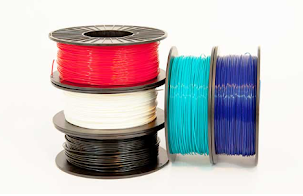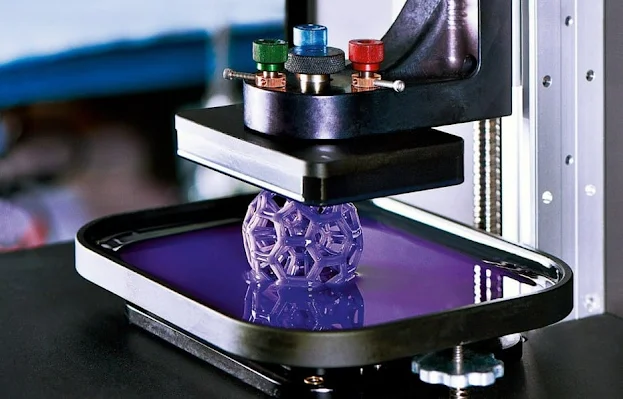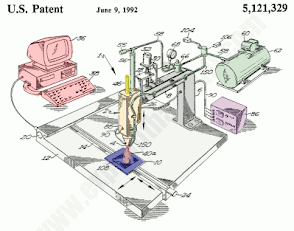In understanding how Additive Layer Manufacturing (ALM) or what is more popularly known as 3D printing, we will not go far from reviewing digital files. In this case the file is converted into a 3-dimensional solid object. 3D printer machines themselves generally have a process or way of working that is almost the same as laser printing, namely creating shapes based on the arrangement of layers of material.
Generally, the process for making 3-dimensional prints is still the same as that used on standard inkjet printers or printers that make many layers of color prints to form an object and look as desired. However, 3D printers do not use ink but rather plastic, molten wax or other materials as materials to print the object.
In contrast to other modeling technologies such as those applied to CNC (Computer Numerical Control) machines, which carry out subtractive manufacturing, 3-dimensional printing machines apply additive manufacturing technology, namely constructing an object from layers of printed material. Meanwhile, on laser printer machines (laser cutting and milling machines), the material will be carved and wasted.
3D Printing Technology has Variations in functional aspects making it a simple technology to use in many fields, be it bionic prosthetics, spare parts for your car or children's toys. It has become such a handy tool now that armed with a 3D printer, you can dream of becoming a chef, inventor, or sculptor.
How Does 3D Printing Work Exactly?
The 3D printing process is similar to paper printing when viewed as the accumulation of multiple layers of material that are arranged sequentially to create a solid three-dimensional object. It develops 3D models one layer at a time, working from the bottom up and working your way up.
With repeated printing of the same area, the printer creates models for hours by converting 3D CAD drawings into many layers of two-dimensional cross-section. Thus, many separate 2D prints are stacked on top of each other, without paper media, and instead of using ink as a material, it uses plastic.
Basically, a 3D printer squeezes molten plastic through a tiny nozzle, the nozzle of which is precisely guided by computer control based on the 3D design. It prints one layer, waits for it to dry, then prints the next layer on it and within hours you have a 3D model.
The way a 3D printer works is by entering design/print data from special 3D printing software, namely CAD, the design that has been created is entered into the 3D printer.
After that the 3D printer will read the design and will melt the plastic material that is connected to the tube and will create a layer on the metal disk. Where the plastic material will harden after being exposed to air.
The process is called FDM (Fused Depositional Modeling) where 3-Dimensional (3D) structures are made by printing the same area, layer by layer using liquid plastic in the same area repeatedly.
3D printers use thermoplastics, especially the ABS type. It is a hard composite plastic, acrylonitrile, combined with a synthetic rubber, styrene butadiene. Since its melting point is over 100°C (220°F) making it solid at room temperature, it is the perfect material for 3D Printing. In addition, ABS pigment is very easy.
Therefore, the theory is that any liquid material that will harden and harden rapidly in a favorable temperature can be used. Patents for materials including ceramics, clay, palladium, paper, rubber, silver, titanium, and wax bring the total to forty-five. In 2011, it was melted chocolate in a 3D printer that brought chocolate cravings to the waves that life created.
There are seven different categories of 3D Printing processes that have been recognized by the ISO/ASTM 52900 standard. The standard developed in 2015 establishes the terminology and standardization of printer classification.
What is the 3D Printing Technique?
This 3D printing technology was first discovered by Chuck Hull from System corp. Since then, 3D printers have developed and are widely used in the fields of architecture, automotive, military, medical fashion and even biotech. The following are 6 techniques for making 3D printing;
1. Selective Laser Sintering (SLS)
Selective Laser Sintering (SLS) is a technique using lasers as a power source to form solid 3D objects. 3D Systems Inc developed stereolithography (SLA) or selectively hardening an object with polymer resin layer by layer using ultraviolet (UV) laser light.
Stereolithography (SLA) is in some ways very similar to Selective Laser Sintering (SLS), the main difference is that Selective Laser Sintering (SLS) uses powdered material in a vat instead of liquid resin like stereolithography (SLA).
Printed materials are usually made of nylon, ceramic, glass, and several types of metal such as aluminum, steel and silver. Because it can be used using various types of materials, SLS technology is very popular for making 3D printing products according to your wishes.
2. Stereolithography (SLA)
Stereolithography or SLA is the first technique for 3D printing. The method is to add continuous layers of photopolymer material towards the top. The material used is initially liquid and will harden when the liquid is exposed to ultraviolet light.
3. Digital Light Processing (DLP)
Digital Light Processing is another 3D printing process that is very similar to stereolithography (SLA). The material used for printing is liquid plastic resin placed in a transparent resin container.
Resin will harden quickly when exposed to large amounts of light. Layers of hardened material can be created with the printer in a few seconds. The printing results will be much stronger and have excellent detail.
The advantage of DLP over SLA is that much less material is used for production, so the costs are lower.
4. Electronic Beam Melting (EBM)
Electronic Beam Melting (EBM) is another type of additive manufacturing for metal parts. The material used in EBM is metal powder which melts and forms layers in each part of the 3D product.
In contrast to SLS, EBM is used to completely melt metal powders. This process is usually carried out under high temperatures up to 1000 °C. The EBM process is quite slow and expensive, apart from that, limited materials are also a drawback of this method, so EBM is not very popular even though it is still used in several manufacturing processes.
5. Selective Laser Melting (SLM)
Selective laser melting (SLM) is a technique that also uses 3D CAD data as a data source to form 3D objects using a high power laser beam that melts metal. The types of metal that can be used in the SLM technique are stainless steel, titanium, cobalt chrome and aluminum.
This 3D printing method is widely applied to create products of complex geometries and structures with surfaces and channels.
6. Fused Deposition Modeling (FDM)
Fused Deposition Modeling (FDM) is used for the development of new products, concept models and prototypes. Even in manufacturing development, this technology is considered easy to use and environmentally friendly. Using this printing method, it is possible to construct objects with complex geometries and cavities.
How Does a FDM Printer Work?
All FDM printers perform the same function: use melted thermoplastic filament to create layers of plastic to form an object. If all goes well, the printer will lay the liquid filament in clean lines on the print mat. This first layer adheres to the surface of the print mat as it cools to keep the object firmly attached while the object is printed.
When the printer lays the molten filament on top of the previous layer, the two layers fuse together to create a relatively solid piece. You will find that all printers share the same basic components to provide this result.
The printer frame and base provide structural support and stability. The heavy base and sturdy frame, ideally made of metal, keep moving parts aligned and dampen vibrations from moving parts. The spool holder is near the top of the frame and allows the spool to rotate freely as the printer extruder pulls on the filament.
The extruder consists of two elements: a mechanical cold tip that pulls the filament from the spool and an electro-thermal hot tip that softens the filament into a viscous stream that flows through a heated nozzle onto the printing base. This print bed is a plate of glass, aluminum, or other material that provides a stable platform for your object to be printed on.
Attached to the frame you'll find a system of rods, rails, belts, and motors driving the print bed and printhead. The electronics on the base interpret the commands in the print file to control all the mechanical and thermal parts. The print file may be on a USB key or a memory card inserted in the printer. Or the printer can be connected to a computer via USB, Ethernet, or WiFi.
1. FDM Printer Variations
Although 3D printers share the same common features, printer manufacturers have come up with many different designs for their products. These are just some of the features you will find when comparing 3D printers.
2. Cartesian versus Delta Desain Design
Printer manufacturers take a different approach to moving printhead onto the print mat. Cartesian printers use rods, rails, and belts to create the x-y-z axis of motion.
The traditional design moves the print head back and forth along the sleeve along the x-axis and elevates the entire arm for z-axis movement. Sliding the print mat back and forth provides movement along the y axis.
Another Cartesian design moves the x-axis arm back and forth along the y-axis while lowering the print base to produce movement along the z-axis. Cartesian printers are the most common design so you will find more resources for help, repairs, and modifications. Cartesian printers also tend to have a larger build surface so you can print wider sections.
However, Cartesian printers ended up being top-heavy, limiting useful height and volume to minimize shock and vibration.
The Delta design suspends the print head on three arms which gives the printers their distinctive triangular shape. The controller circuit adjusts the length and angle of the arm to move the print head in the x, y, and z directions over a stationary print mat. With a less heavy design, the Delta printer can be much taller which allows you to print taller objects.
This printer also moves the print head faster with less jerks. As a result, Delta printers get jobs done faster than Cartesian printers. On the other hand, the build platform is smaller which limits the Delta printer's ability to print multiple objects at a time.
3. Bowden Versus Direct Feed Extruder
Many 3D printers use a Bowden design that separates the cold end and the hot end of the extruder. The cold end is near the spool holder, feeding the filament through a flexible plastic Bowden tube to the hot end on the printhead.
This makes the printhead lighter which increases stability and allows for faster print speeds. However, friction within the Bowden tube can cause the filament to break or jam.
Bowden tubes can also be problematic when using flexible filaments. Other 3D printers use a direct feed approach that combines a cold end and a hot end inside the print head. Live feed extruders are more responsive to changes in extrusion and retraction commands.
Flexible filaments also perform better with direct feed extruders. However, the printhead will be much heavier which makes starting, stopping, accelerating, and decelerating the printhead harder and causing shock and vibration.
4. Heated versus Unheated Print Mat
Most 3D printers heat the print base to increase the adhesion of the first coat. The thermoplastic tends to shrink when it cools creating a pressure that can pull the first layer off the bed. Raising the layer temperature to 50ºC or higher will keep the first layer warmer for longer and reduce the stress.
An unheated bed makes the printer less expensive but limits your use of PLA. You can't use a material like ABS without a heated bed.
5. Multi Filament Printing
High-end 3D printers can have two or more printheads so you can use different filaments in the same print process. Most commonly, it allows you to use custom support materials to make post-processing easier. Alternatively, you can incorporate both flexible and rigid elements in your design without having to print separate sections.
Conclusion
3D Printing is the process of creating 3-dimensional solid objects from digital files. The creation of 3-Dimensional (3D) objects is achieved using an additive process (additional materials). In the printing process, an object is created by laying materials layer by layer until the object is created.
Each layer appears as a very thin horizontal cross-section of the object. Basically, it is not much different from ordinary printing tools, only the output produced is 3D.
3 dimensions or usually abbreviated as 3D or called space dimensions are objects that have length, width and height. This term is usually used in the fields of art, animation, computers and mathematics. Every three-dimensional shape has a capacity, also called volume.
The main principle for 3D printer printing is that it requires data in 3 dimensions or what is called 'three-dimensional digital data'. In the world of engineering, it is usually called CAD (Computer Aided Design). CAD is an application that is capable of displaying data in 3 dimensions.
OK, that's the work process commonly used in 3D printing, the various techniques are quite complex. Hopefully this article can help you operate it and get good, quality results...!!








